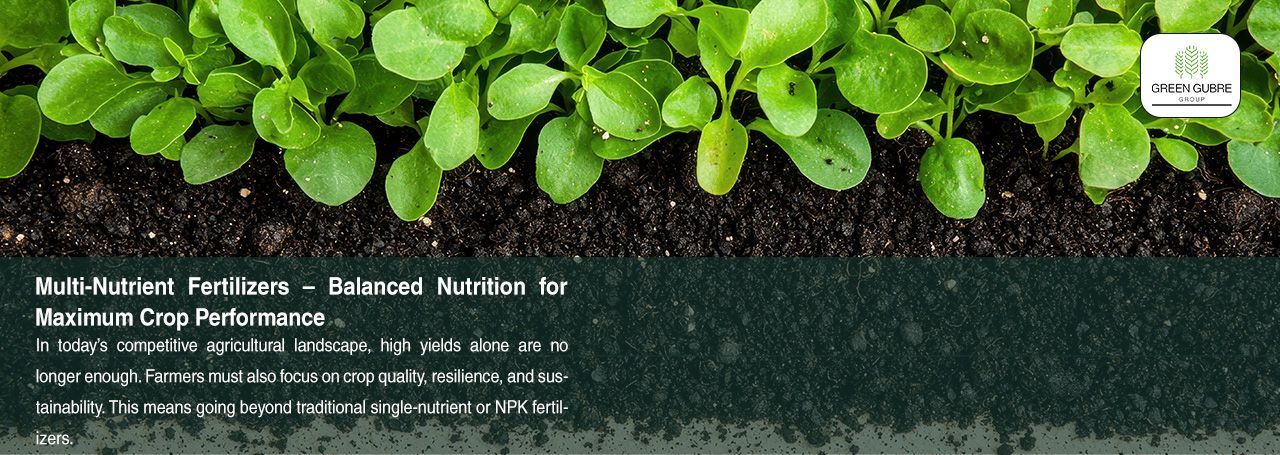Multi-Nutrient Fertilizers – Balanced Nutrition for Maximum Crop Performance
Multi-Nutrient Fertilizers – Balanced Nutrition for Maximum Crop Performance

Introduction: Beyond NPK – The Power of Balanced Fertilization
In today’s competitive agricultural landscape, high yields alone are no longer enough. Farmers must also focus on crop quality, resilience, and sustainability. This means going beyond traditional single-nutrient or NPK fertilizers. Multi-nutrient fertilizers provide a complete and balanced nutrition profile, combining primary, secondary, and micronutrients in one application. This approach ensures that crops receive all the essential elements needed for optimal growth, development, and productivity.
With increasing soil nutrient depletion, rising global food demand, and the push for efficient resource use, multi-nutrient fertilizers have become indispensable in modern crop management.
What Are Multi-Nutrient Fertilizers?
Multi-nutrient fertilizers are blends or compounds that supply more than one essential plant nutrient. Unlike straight fertilizers that provide only nitrogen, phosphorus, or potassium, these formulations deliver combinations of:
- Primary nutrients: Nitrogen (N), Phosphorus (P), Potassium (K)
- Secondary nutrients: Calcium (Ca), Magnesium (Mg), Sulfur (S)
- Micronutrients: Zinc (Zn), Boron (B), Iron (Fe), Manganese (Mn), Copper (Cu), Molybdenum (Mo)
They come in various forms:
- Compound NPKs with micronutrients
- Granular or water-soluble blends
- Custom-mixed formulas based on soil and crop needs
- Fortified organic or biofertilizer mixtures
Multi-nutrient solutions ensure comprehensive crop nutrition, especially in nutrient-deficient or intensively farmed soils.
Why Balanced Nutrition Matters
Just like humans, plants need a complete diet—not just energy (N) and building blocks (P and K), but also enzymes, hormones, and defense compounds that require micronutrients and secondary elements. Here’s why balanced fertilization is essential:
| Nutrient Type | Role in Plants |
|---|---|
| Nitrogen (N) | Leaf and stem growth, protein formation |
| Phosphorus (P) | Root development, flowering, and seed production |
| Potassium (K) | Water regulation, disease resistance, fruit quality |
| Calcium (Ca) | Cell wall strength, fruit firmness |
| Magnesium (Mg) | Chlorophyll production, enzyme activation |
| Sulfur (S) | Amino acid synthesis, oil content in crops |
| Micronutrients | Enzyme activation, hormone balance, stress resilience |
Even minor deficiencies in one nutrient can limit yield and reduce fertilizer efficiency.
Benefits of Multi-Nutrient Fertilizers
1. Maximized Crop Yield and Quality: Balanced nutrition supports all growth stages—from early root establishment to grain or fruit filling—ensuring higher yields and better quality.
2. Improved Nutrient Use Efficiency (NUE): Nutrients work synergistically. Providing them in balanced ratios ensures better uptake and utilization, reducing loss and increasing ROI.
3. Soil Health Management: Multi-nutrient fertilizers can reduce nutrient mining and rebalance soil profiles—especially when combined with soil testing.
4. Labor and Cost Efficiency: Instead of applying multiple products, farmers can save time and labor with a single, well-balanced application.
5. Climate Resilience: Micronutrients and sulfur improve drought and stress tolerance—helping crops survive extreme weather.
🔗 Fertilizer Focus – Advantages of Balanced Nutrient Programs
Common Multi-Nutrient Fertilizer Products
| Product Type | Description | Use Cases |
|---|---|---|
| NPK + S | Combines nitrogen, phosphorus, potassium, and sulfur | Cereals, oilseeds, and vegetables |
| NPK + Micronutrients | Fortified with Zn, B, Fe, etc. | Fruits, vegetables, legumes |
| Compound Fertilizers | Chemically integrated granules (e.g., 15-15-15 + B) | Broadcast or basal applications |
| Water-Soluble Fertilizers | Fully soluble in irrigation water | Greenhouses, fertigation systems |
| Organic Multi-Nutrient Mix | Enriched compost or biofertilizers with micronutrients | Organic and regenerative farming |
Best Practices for Use
- Test your soil first to identify deficiencies and tailor your nutrient mix accordingly.
- Apply at the right growth stage, especially during early root development and flowering.
- Combine with precision irrigation to deliver nutrients directly to the root zone.
- Avoid over-application—excess micronutrients can be toxic.
- Integrate with crop rotation to maintain long-term nutrient balance.
Green Gubre Group’s Multi-Nutrient Solutions
We offer a wide range of multi-nutrient fertilizers tailored for diverse crops and soils:
- NPK + S + Zn Granules for maize, rice, and wheat
- 15-15-15 + B + Mg blends for fruits and vegetables
- Water-soluble NPK + Micronutrient mixes for fertigation.
- Customized multi-nutrient packs based on regional soil maps and crop goals
Our agronomy support team assists in:
- Soil and tissue analysis
- Nutrient mapping and crop modeling
- Application timing and equipment calibration
Conclusion: Feed Your Crops the Full Menu
In the quest for resilient and profitable farming, no nutrient can be overlooked. Multi-nutrient fertilizers deliver a balanced, efficient, and effective nutrition program that maximizes yield, safeguards soil health, and supports environmental sustainability.
Whether you’re managing a greenhouse, an open field, or a large-scale farm, the future of fertilization lies in comprehensive, balanced nutrient delivery.
Choose smarter. Choose balanced. Choose Green Gubre Group.




